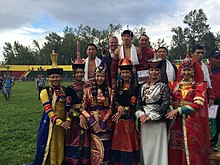тывалар | |
|---|---|
 Tuvans in Russia | |
| Total population | |
| c. 312,194 | |
| 295,384 (2021) | |
| ∟ | 279,789 (7,189 Todjins)[1] |
| ∟ | 2,719[1] |
| ∟ | 2,051[1] |
| ∟ | 1,308[1] |
| ∟ | 1,124[1] |
| 14,456 (2021 est.) | |
| 2,354 (2020 est.)[2] | |
| Languages | |
| Tuvan[3] | |
| Religion | |
| Predominantly Tibetan Buddhism (Lamaism), Tengrism | |
| Related ethnic groups | |
| Altaians, Chulyms, Kumandins, Shors, Teleuts, Tofalar, Dukha, Soyot, Kyrgyz, and other Turkic peoples | |
| People | Tuvan / Tyvans Тывалар Тувинцы |
|---|---|
| Language | Tuvan / Tyvan Тыва дыл |
| Country | Tuva / Tyva Тува Тыва |
The Tuvans (from Russian тувинцы tuvincy) or Tyvans (from Tuvan тывалар tyvalar) are a Turkic ethnic group indigenous to Siberia[4] that live in Tuva, Mongolia, and China. They speak the Tuvan language, a Siberian Turkic language.[5] In Mongolia, they are regarded as one of the Uriankhai peoples.[6]
Tuvans have historically been livestock-herding nomads, tending to herds of goats, sheep, camels, reindeer, cattle, and yaks for the past thousands of years. (This is, in fact, evident in the Tuvan folk song "Tooruktug Dolgai Tangdym".) They have traditionally lived in yurts covered by felt or chums, layered with birch bark or hide that they relocate seasonally as they move to newer pastures. Traditionally, the Tuvans were divided into nine regions called khoshuun, namely the Tozhu, Salchak, Oyunnar, Khemchik, Khaasuut, Shalyk, Nibazy, Daavan and Choodu, and Beezi. The first four were ruled by Uriankhai Mongol princes, while the rest were administered by Borjigin Mongol princes.[7]
- ^ a b c d e f "Национальный состав населения". Federal State Statistics Service. Retrieved 30 December 2022.
- ^ Mongolian Census 2020 Main report (in Mongolian)
- ^ The Tuvans of Mongolia: Peculiarities of Contemporary Ethnic Development
- ^ "Y-DNA haplogroups of Tuvinian tribes show little effect of the Mongol expansion". Indo-European.eu. 12 August 2018. Retrieved 15 July 2020.
- ^ "CNBC Asia-Pacific: Network Schedule". Advameg, Inc. everyculture.com.
- ^ "Uriyangqad, which is the plural form of Uriyangqan, itself originally a plural of Uriyangqai."
KRUEGER, John (1977). Tuvan Manual. p. 10. Which quotes from Henry Serruy's "The Mongols in China during the Hung-wu Period", Melanges chinois et bouddhiques, vol 11. pp. 282–283, Brussels 1959. - ^ The Uralic and Altaic Series By Denis Sinor, John R. Krueger, Jüri Kurman, Larry Moses, Robert Arthur Rupen, Vasilij Vasilevič Radlov, Kaare Grłnbech, George Kurman, Joshua A. Fishman, Stephen A. Halkovic, Robert W. Olson, V Diószegi, American Council of Learned Societies, Melvin J. Luthy, Luc Kwanten, Karl Nickul, A. A. Popov, Susan Hesse, Routledge, 1996.